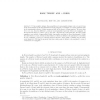Free Online Productivity Tools
i2Speak
i2Symbol
i2OCR
iTex2Img
iWeb2Print
iWeb2Shot
i2Type
iPdf2Split
iPdf2Merge
i2Bopomofo
i2Arabic
i2Style
i2Image
i2PDF
iLatex2Rtf
Sci2ools
JCT
1998
1998
Rook Theory and t-Cores
If t is a positive integer, then a partition of a non-negative integer n is a t−core if none of the hook numbers of the associated Ferrers-Young diagram is a multiple of t. These partitions arise in the representation theory of finite groups and also in the theory of class numbers. We prove that if t = 2, 3, or 4, then two different t−cores are rook equivalent if and only if they are conjugates. In the special case when t = 4, since c4(n) = 1 2 h(−32n − 20) when 8n + 5 is square-free, the above result suggests a new method of approaching Gauss’ class number problem for these discriminants. Unlike the cases where 2 ≤ t ≤ 4, it turns out that when t ≥ 5 there are distinct rook equivalent t−cores which are not conjugates. In fact, we conjecture that for all such t, there exists a constant N(t) for which every integer n ≥ N(t) has the property that there exists a pair of distinct rook equivalent t−cores of n which are not conjugates.
| Added | 22 Dec 2010 |
| Updated | 22 Dec 2010 |
| Type | Journal |
| Year | 1998 |
| Where | JCT |
| Authors | James Haglund, Ken Ono, Lawrence Sze |
Comments (0)

